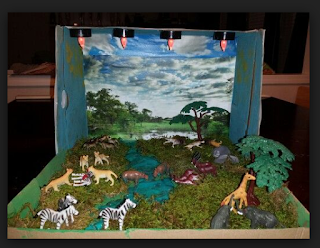For now, students are tasked with CHOOSING THEIR ANIMAL by Thursday of this week. They are NOT to begin the project. The written portion of the project will come home in chunks as homework.
In case your child loses the documents coming home... here it all is:
Grade
2 Science Project – Animals
Project
is due in class on Monday, December 12th.
As
part of our unit on animals, the students will be making a diorama in class.
The purpose of this activity is that they begin to understand the process of
inquiry (research) and that they develop and share some knowledge about a
particular animal.
For
this project, you are to research an animal of your choice (I will approve the
animal and let you know what it is).
Part
1 – Report (Do NOT use translation tools)
Your
report must include:
Cover
Page
Your
cover page needs to have the following:
- Title
- Illustration of your animal in its natural habitat in colour (your own artwork only).
- Your name and the date.
Main
Report (to be completed at HOME)
- Introduction – explain why you chose this animal (1 or 2 lines).
- Research about your animal under the following headings:
·
Appearance (including to which animal group it belongs –
mammal etc.)
·
Habitat
·
Diet
·
Life Cycle
·
Adaptation to the Environment
·
Interesting Facts
Your
report should be 1 to 2 pages long. You may use library books, class books and
the internet to research your animal.
Part
2 - Presentation to the class
Short
presentation (2-3 minutes) telling us what you have learned about your animal. Don’t read your research, just tell us what you
know.
Part
3 – Diorama (to be completed at SCHOOL)
Students
will be given class time over the next few weeks, to create a diorama. Each student must bring in a shoe-box. Please help your child gather materials (e.g.
a fish might need items to represent shells, seaweed, other marine animals etc.
and a lion might need items to represent a savannah, rocks, grasses, sand
etc. Nature images cut out from
magazines could make for a lovely background.) I can supply paper, paint, glue,
and a few additional materials. Each
important element of the diorama needs to be labeled. These elements include:
- The animal
- Items of importance in its habitat (e.g. ice, or rainforest).
- Prey
- What preys on the animal
Students
will create a title for their diorama e.g. Zebras by Jimmy Carson, Grade 2.
This title will be pasted to the front of their diorama so that we may all
appreciate each student’s hard work!
Below
are some examples of what a diorama looks like:
Useful websites:
FOR TRANSLATING
WORDS:
Please remember not to use translation
tools such as (but not limited to) Google Translate. It is important that your
child try to make sentences him/herself. I am not looking for perfection but
for effort. Thanks!
Grade
2 Science Project – Animals
RUBRIC
Level 1 (D)
|
Level 2 (C)
|
Level 3 (B)
|
Level 4 (A)
|
|
Knowledge
of content
|
Demonstrates limited knowledge of content.
|
Demonstrates some knowledge of content.
|
Demonstrates considerable
knowledge of content.
|
Demonstrates thorough
knowledge of content.
|
Understanding
|
Demonstrates limited understanding of
content.
|
Demonstrates some understanding of
content.
|
Demonstrates considerable understanding
of content.
|
Demonstrates thorough understanding of
content.
|
Creativity
|
Produces works of art that express ideas
inspired by observations
of nature with limited care or creativity.
|
Produces works of art that express ideas
inspired by observations
of nature with some care or creativity.
|
Produces works of art that express ideas
inspired by observations
of nature with considerable care or creativity.
|
Produces works of art that express ideas
inspired by observations
of nature with great care and creativity.
|
Written communication
TRANSLATION TOOLS ARE NOT PERMITTED!
|
Uses
conventions, vocabulary, and terminology about animals with limited
effectiveness.
|
Uses
conventions, vocabulary, and terminology about animals with some
effectiveness.
|
Uses
conventions, vocabulary, and terminology about animals with considerable
effectiveness.
|
Uses
conventions, vocabulary, and terminology about animals with a high degree of
effectiveness.
|
Written presentation
|
Written
work is not neat and tidy or well-organized, and does not demonstrate that a
good effort has been made.
|
Written
work is somewhat neat and tidy, well-organized, and demonstrates some degree
of effort.
|
Written
work is neat and tidy, well-organized, and demonstrates a good effort.
|
Written
work is extremely neat and tidy, well-organized, and demonstrates a great
deal of effort.
|
Research
|
Little
evidence of research.
|
Some
evidence of research. Research is accurate/some categories are complete.
|
Project
is researched and accurate. Most categories are complete.
|
Project
is researched and accurate. All categories are complete.
|
Oral presentation
|
Presentation is not serious and/or very
little information is shared with the class.
|
Presentation is serious but little
information is shared with the class, or vice versa.
|
Presentation is serious and some
information is shared with the class.
|
Presentation is serious and much
information is shared with the class.
|
Attentitive listening/
respect |
Demonstrates appreciation appropriately
as an audience member, with limited effectiveness.
|
Demonstrates appreciation appropriately
as an audience member, with some effectiveness.
|
Demonstrates appreciation appropriately
as an audience member, with considerable effectiveness.
|
Demonstrates appreciation appropriately
as an audience member, with a high degree of effectiveness.
|


No comments:
Post a Comment